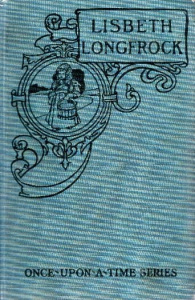
archives for 01/2009
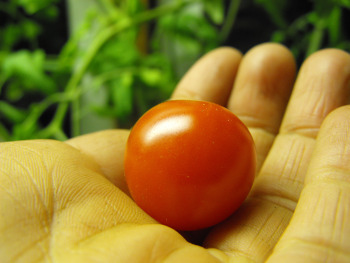 I get so caught up in the flow of seasons,
always joyously anticipating the next one along the chain.
Yesterday, I noticed that the darkness was already coming later --- 6
pm and Mark and I were still out preparing firewood for the
night. Walking Lucy, I found mole salamander tadpoles drifting
under the ice in floodplain puddles, their feathery gills sucking
oxygen out of the frigid water. Signs of spring on the last day
of the year!
I get so caught up in the flow of seasons,
always joyously anticipating the next one along the chain.
Yesterday, I noticed that the darkness was already coming later --- 6
pm and Mark and I were still out preparing firewood for the
night. Walking Lucy, I found mole salamander tadpoles drifting
under the ice in floodplain puddles, their feathery gills sucking
oxygen out of the frigid water. Signs of spring on the last day
of the year!
Inside, we harvested the first tomato off the plant Daddy gave us at
Thanksgiving. I've had zero luck with growing tomatoes indoors in
winter until this plant came along. But this is a hybrid variety
carefully bred for indoors life. Daddy paid fifty cents per seed
for his start, but quickly learned that he could keep the plants going
indefinitely by taking cuttings (one of which he gave me.) Our
house is really too cold even for this little guy, and about 70% of the
flowers don't manage to set fruit, but I'm curious to see how long I
can keep it going.
Happy New Year, everybody! I have a feeling that this year will
be the best one yet!
 This is a picture of hen number 6. Hen number
5 if you ask Anna. She's at the bottom of the pecking order and had to
be isolated because it was just too sad watching her getting picked on
by the other hens.
This is a picture of hen number 6. Hen number
5 if you ask Anna. She's at the bottom of the pecking order and had to
be isolated because it was just too sad watching her getting picked on
by the other hens.
Now she gets to roam free on most days, adding a certain flare to the
place that makes me feel like I'm on the set of a movie and she's been
added at the last minute for additional atmosphere for whatever new and
wild scene is coming up next.
2008 was filled with a generous portion of good and happy scenes that
make me feel confident I'm exactly where I need to be and doing exactly
what I need to be doing. I offer everyone reading this a warm and
happy toast for good tidings in 2009.
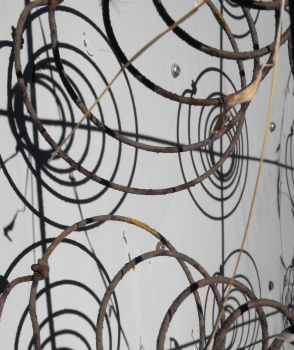 Inspired by Mike's 2008
summary photos, and by Mark's notion that we should take New Year's
Day as a holiday, I set out Thursday afternoon with our camera in
hand. It's harder to find color in the winter, but the stark
shapes and lines can make up for the lack of color. First I got
caught up in the shadows cast by the bed springs we'd dug out of the
garden. Spiralling
circles --- I almost got lost right there.
Inspired by Mike's 2008
summary photos, and by Mark's notion that we should take New Year's
Day as a holiday, I set out Thursday afternoon with our camera in
hand. It's harder to find color in the winter, but the stark
shapes and lines can make up for the lack of color. First I got
caught up in the shadows cast by the bed springs we'd dug out of the
garden. Spiralling
circles --- I almost got lost right there.
But I really wanted to visit
my favorite sycamore grove. Down in the floodplain, several large
sycamores grow in a ten foot in diameter ring. They clearly mark
the borders of 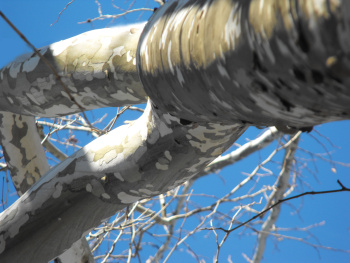 an ancient sycamore's root
mass, and I can almost see the parent sycamore in my mind's eye.
I lay down between them and looked up, just in time to catch a photo of
a sycamore turned human.
an ancient sycamore's root
mass, and I can almost see the parent sycamore in my mind's eye.
I lay down between them and looked up, just in time to catch a photo of
a sycamore turned human.
Holidays evade me
sometimes. Thanksgiving and the winter solstice I can wrap my
mind around. I'm so used to the family elements of Christmas that
I follow through without giving it much thought. But the other 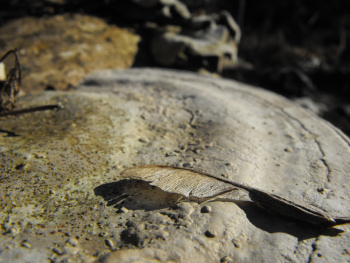 holidays that Mark named off
when I dubiously asked him which ones he's used to celebrating --- New
Year's Day, Memorial Day, Labor Day --- are blurs in my mind.
What do they mean? How do you celebrate a holiday you don't
understand?
holidays that Mark named off
when I dubiously asked him which ones he's used to celebrating --- New
Year's Day, Memorial Day, Labor Day --- are blurs in my mind.
What do they mean? How do you celebrate a holiday you don't
understand?
I'm afraid I bickered with Mark before agreeing to take the day
off. Now I'm glad he perservered --- so I cooked him up a pound
of bacon and a double recipe of the fluffiest white pancakes in my
cookbook as an apology. You're right, Mark! No matter what
the holiday means, it's worth it to spend time in the moment.
We had a
small dusting of snow to wake up to this morning which makes our crude
footbridge a bit too slippery to cross.
Option number two is a series
of cinder block stepping stones just to the side of the ford. This 14
second video is how it looked about an hour ago.

Here's a picture of Lucy with our footbridge in the background where
the creek has a curve in it. The panoramic nature of the photo is
thanks to the Fuji
Finepix S1000fd. It has a pretty neat built in feature that allows you to
stitch three pictures into one long image.
After you take the first
shot you save it in the memory and the next frame has about a fifth of
the last image in a ghost like form that allows you to line up the
picture exactly where you need it.
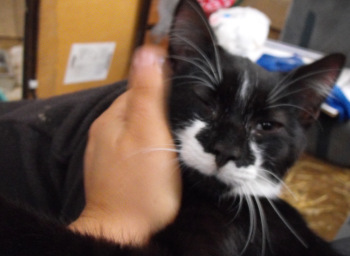 Yesterday, I jokingly told Mark that I'd gone
to the dump (the source of our current cat) and found another cat, who
I was now hiding in the barn. No, no --- I changed my mind ---
I'd stolen sweet little Bonnie from Mark's mom and had her hidden in
the barn. We both laughed and thought no more about it.
Yesterday, I jokingly told Mark that I'd gone
to the dump (the source of our current cat) and found another cat, who
I was now hiding in the barn. No, no --- I changed my mind ---
I'd stolen sweet little Bonnie from Mark's mom and had her hidden in
the barn. We both laughed and thought no more about it.
But this morning as I started to move the chicken tractors through
winter mud, I heard a plaintive meow come from the barn. I'd just
left Huckleberry sleeping soundly on the sofa, but I thought it was
possible he'd slipped out of the house and gotten his dainty paws wet
or been chased by Lucy. So I told the chickens to wait on me and
went to check the noise out.
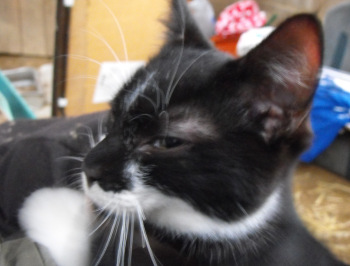
Cowering behind our array of boxes and cast off belongings
was...Bonnie??? The little cat had most of her markings, a white
vest and white paws on an otherwise black fur coat. But this
little cat was smaller and oh so skinny when I finally tempted it to
let me pick it up. It was also a boy, just the same size
Huckleberry was when I found him --- reaching that gawky adolescent
stage where people tend to drop them off. (Later, Mark found a
towel on the road a mile from our house, one that hadn't been there
yesterday, confirming our belief that the little cat got dumped.)
Just two weeks ago, Mark's mom asked us if we wanted another cat.
And without even checking with each other Mark and I both said
"No!" Huckleberry's a handful all by himself. And yet ---
if a cat walks a mile through the woods to find us, can we really tell
it that we're going to renege on the contract humanity made with cats a
few thousand years ago? The truth is, I'm a sucker for
strays. Looks like we'll be taking the new cat to the vet
tomorrow, and if it gets a clean bill of health introducing it to
Huckleberry soon after. I guess I should be a little more careful
what I joke about!
Huckleberry is about to get a new friend as
you may have read in the previous post.
I thought I would post this picture in an attempt to show him he was
here first and we are not trying to replace him with the new cat, but
to maybe add a bit of feline companionship to his already full and rich
life of napping, meowing, eating, and reading on the couch with Anna.
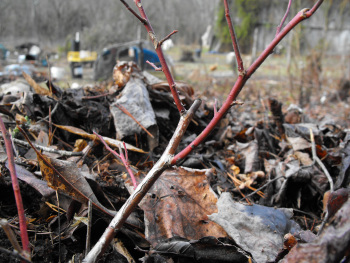 I hope my poor, malingering blueberries will
malinger no more! The little things haven't had much going for
them in the two years they've been in the yard. I bought them for
a few bucks at Wal-Mart when they'd barely grown a root apiece, then I
stuck them in sweet soil and mulched them with nitrogen-leaching wood
chips.
I hope my poor, malingering blueberries will
malinger no more! The little things haven't had much going for
them in the two years they've been in the yard. I bought them for
a few bucks at Wal-Mart when they'd barely grown a root apiece, then I
stuck them in sweet soil and mulched them with nitrogen-leaching wood
chips.
I'm hoping to
remedy the damage with a little TLC. Yesterday I treated them
to some soil acidifier, as well as a nice mulch of mixed pine needles
and decidous leaf mould from the hill above the house. I also
used a gift certificate to order a few larger plants from a more
reputable nursery. The pullets are busy
scratching up and fertilizing the new ground in preparation for our
second round of blueberries' arrival this spring.
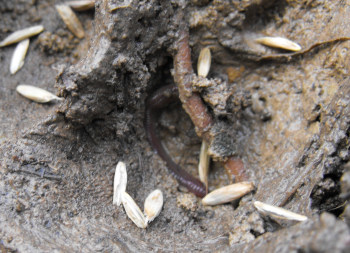
I also decided to experiment a bit with the mudhole between the
nectarine and grapes. The soil there is pure clay and in our
recent wet spell the chickens churned it up into a mass of mud. I
found some old grain seeds hidden behind my desk and sowed them in the
muddiest spots. If I remember right, the grain is rye, meant to
be planted in early fall as a cover crop. But maybe it'll do
something to hold the soil together and outcompete the Japanese
honeysuckle which is what naturally grows in that area. Only time
will tell...
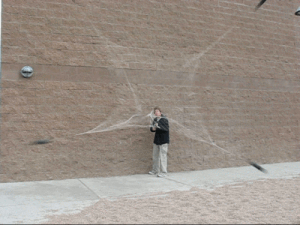
Joel Johnson over at Boing
Boing posted this interesting net gun
that you can build for around 50 bucks.
The net is 90 square feet and will travel 15 to 25 feet using
compressed air.
This could make catching extra zippy chickens a bit easier, and it
provides a non-lethal way of dealing with those neighborhood kids who
keep jumping into your yard to retrieve their ball or frisbee.
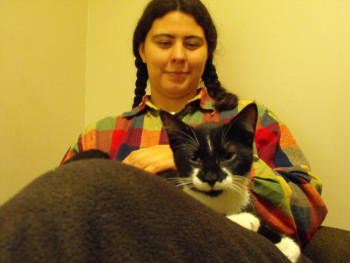 The vet says Strider has a four degree
temperature and is eight months old. For $86, we came home with
dewormer, antibiotics, and a more impressive ear mite medicine for
Huckleberry whose ear mites have been resisting all over the counter
meds for months. The two haven't met, and won't until Strider
fights off his upper respiratory infection. For now, he's holed
up in a cozy nook in the barn.
The vet says Strider has a four degree
temperature and is eight months old. For $86, we came home with
dewormer, antibiotics, and a more impressive ear mite medicine for
Huckleberry whose ear mites have been resisting all over the counter
meds for months. The two haven't met, and won't until Strider
fights off his upper respiratory infection. For now, he's holed
up in a cozy nook in the barn.
The trip to the vet went pretty smoothly, all things considered.
Strider was a bit of a wiggler at first, but soon settled in and didn't
make any sudden moves amid a waiting room full of canines. The
only small problem was a bit of projectile pooping on the walk back to
the barn at the end of the day --- Strider really did try to warn me by
wriggling and meowing, but I held on tight thinking that he wanted to
get down and get lost in the floodplain. As a last resort, he
pooped into midair, barely soiling my coat. I dropped him in a
hurry to let him finish, just as Lucy came barreling down over the hill
to greet us. Mark tackled Lucy while Strider fled into the cave
created by an upturned root mass, to be slowly wheedled out again with
honeyed tones. Back in the safety of his barn, he ate and drank
ravenously before settling down to pur on my lap.
I have to admit that his manners are impeccable, all things
considered. Yesterday, I talked about trying to give him to my
brother. Today I know he's here to stay.
This is the view looking down into our 1000
gallon tank we use for irrigation and other water related chores.
It's up on a hill so gravity can help the water along its path to our
sink and various parts of the garden.
This addition was a huge improvement over our previous set up which
used a 50 gallon barrel elevated in the air by 10 feet. We found our
tank on Craigslist for 300 dollars, but they usually cost twice that if
you need to buy a new one.
We've had nearly ten inches of rain in the last month, two and a half of which fell in the last twenty four hours. Today was supposed to be a day of meetings in the big city, but no one's leaving the property anytime soon. The video below is our driveway....
...and this is the creek where it's spilled out over the floodplain.
 It's snowy and cold now as the flood waters
begin to recede. Time to perk us all up with a giveaway!
Daddy has made a cutting of his Red Cherry Flavorita F1 tomato, a
hybrid variety very well suited for indoors life. By the time our
giveaway ends Saturday night, it should have some roots and be ready to
be poked into a pot in its new home.
It's snowy and cold now as the flood waters
begin to recede. Time to perk us all up with a giveaway!
Daddy has made a cutting of his Red Cherry Flavorita F1 tomato, a
hybrid variety very well suited for indoors life. By the time our
giveaway ends Saturday night, it should have some roots and be ready to
be poked into a pot in its new home.
Growing tomatoes indoors in the winter is the holy grail for a lot of
folks. It's hard to leave behind the sweet, juiciness of real
tomatoes when the summer sun fades. But it's equally hard to keep
winter tomatoes going since they require lots of sun. This
variety is much hardier, able to thrive under a growlight on a
windowsill. But be aware that like any tomato it will not set
fruit if your temperatures fall below 50 F! (That's probably not
a problem for those of you who don't heat with wood. 
Anyhow, I'd love to hear from you all and perk me up on this cold
winter's day! Check out our giveaway
guidelines and enter. Thanks, Daddy, for taking a cutting for
our winner!
Today was a day that begs one to surrender to
the forces of nature.
The creek was transformed overnight into a mighty river that seemed to
be making up for lost time in its haste to get where it's going.
Lucy likes to monitor the shoreline during heavy activity like this.
She knows it will eventually yield something interesting enough to chew
on and maybe bring back to us for closer inspection.
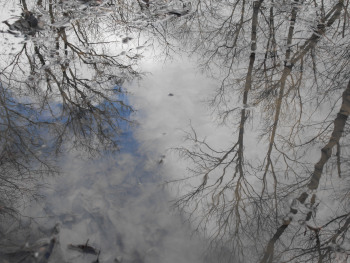 Twenty four hours later, the rain has stopped
and the flood waters have begun to recede. Every plant in the
floodplain has been swept so that it faces downstream and a thin layer
of sediment is being left behind to fertilize the ground. The
salamander tadpoles I found a few weeks ago have been washed to new
puddles and I find them in unexpected places, making me take more care
where I place my feet.
Twenty four hours later, the rain has stopped
and the flood waters have begun to recede. Every plant in the
floodplain has been swept so that it faces downstream and a thin layer
of sediment is being left behind to fertilize the ground. The
salamander tadpoles I found a few weeks ago have been washed to new
puddles and I find them in unexpected places, making me take more care
where I place my feet.
Our driveway crisscrosses three sections of the "alligator swamp" ---
areas we call "baby fords" --- before it reaches the creek
proper. One of these baby fords is a drainage ditch which
previous farmers dug in an attempt to farm the floodplain, but the
other two are actually the original bed of the creek. At some
time in the last fifty years since our area's topo map was creat ed, the farmers got together
and dug a new, straight channel to make more dry land for their fields
on either side. I can't help wondering if the channelizing of the
creek is one of the causes of its frequent floods.
ed, the farmers got together
and dug a new, straight channel to make more dry land for their fields
on either side. I can't help wondering if the channelizing of the
creek is one of the causes of its frequent floods.
Yesterday, I could only reach baby ford number one before the flood
waters turned me back. This morning, I made it all the way to
baby ford number three, just barely out of sight of the
footbridge. Maybe by this evening, we'll know if the footbridge
survived the flood.
I made it out to the mailbox this evening for
the first time in 48 hours.
It's always a relief to see the footbridge make it through yet another
beating by mother nature.
The next version will be wider, a bit longer, and elevated about 18
inches on concrete pillars.
--- Cassi from Indiana
On the small scale,
organic gardening is actually pretty easy. Here are a few tips to
get you started:
 Pick easy plants to start with.
Some plants are notoriously difficult to grow without chemicals, so
skip the eggplant until you're more experienced. You're bound to
have good luck with greens (spinach, swiss chard, collards, kale, and
mustard) no matter what you do and can't go far wrong with leaf lettuce
either as long as you grow it in the cool season. Try a summer
squash (we like the hybrid straightneck yellow bush squashes which
don't take over the garden) and a winter squash (butternut is our
favorite for flavor and disease resistance.) Throw in a few
tomatoes and that's probably enough for your first garden.
Read more....
Pick easy plants to start with.
Some plants are notoriously difficult to grow without chemicals, so
skip the eggplant until you're more experienced. You're bound to
have good luck with greens (spinach, swiss chard, collards, kale, and
mustard) no matter what you do and can't go far wrong with leaf lettuce
either as long as you grow it in the cool season. Try a summer
squash (we like the hybrid straightneck yellow bush squashes which
don't take over the garden) and a winter squash (butternut is our
favorite for flavor and disease resistance.) Throw in a few
tomatoes and that's probably enough for your first garden.
Read more....
 Herrick Kimball from the deliberate agrarian
blog has put together a how to book
on making your own heavy duty garden cart.
Herrick Kimball from the deliberate agrarian
blog has put together a how to book
on making your own heavy duty garden cart.
He says his version weighs less than the manufactured ones available,
is lighter, and can be built cheaper.
This book is number 8 for Mr Kimball, and he shares some interesting
tips in his latest post
on the process of low budget self publishing.
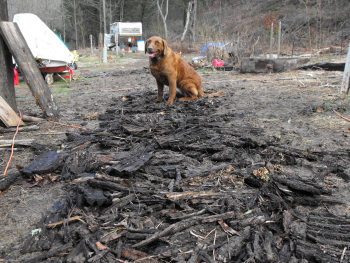 Mud, mud, mud. I know it's made an
appearance in nearly every entry I've made for the last month.
That's because mud has been such a big presence in our life ever since
the ground started to freeze and the rain turned the upper layer into a
wet, goopy mess. Try as I might (granted, not all that hard), I
can't keep the trailer floor from acquiring a thick layer of dirt every
few days as we track in boots covered with mud.
Mud, mud, mud. I know it's made an
appearance in nearly every entry I've made for the last month.
That's because mud has been such a big presence in our life ever since
the ground started to freeze and the rain turned the upper layer into a
wet, goopy mess. Try as I might (granted, not all that hard), I
can't keep the trailer floor from acquiring a thick layer of dirt every
few days as we track in boots covered with mud.
But for the last few days, the dirt on our floors has been a little
less extreme. We've been collecting the bark which falls away
from the walnut logs as we split them for firewood and laying it out in
a path outside our door. I love it when we can solve a problem
for free using discarded materials!
 I would like to send out a big thank you for
everyone who sent me warm and happy birthday greetings.
I would like to send out a big thank you for
everyone who sent me warm and happy birthday greetings.
It was an excellent year being 39, and I'm confident my 40th year will
be filled with plenty of exciting and happy events.
The groovy picture is from a hand drawn card sent from Anna's mom which
depicts Lucy, Huckleberry, and Strider.
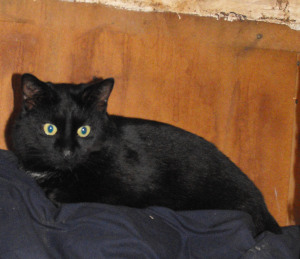 Saturday --- time for Strider to come play
with the big cat. I carry him inside through the rain and
instantly both cats are terrified of each other. Huckleberry
hisses and flees to the top of the north futon. Strider meows
mournfully and flees to hide under the south futon.
Saturday --- time for Strider to come play
with the big cat. I carry him inside through the rain and
instantly both cats are terrified of each other. Huckleberry
hisses and flees to the top of the north futon. Strider meows
mournfully and flees to hide under the south futon.
I lie between them, reading about dragons and sailors. But the
cats' war wears me out, and I slide into sleep. I wake to more
standoff, and eventually I put Strider back out in the barn and coddle
Huckleberry back into his usual slug-like state.
Sunday morning. The creek has risen again and is lapping up
against the bottom of the footbridge. Huckleberry won't come to
breakfast, so I bring Strider inside again and he settles into the nook
between my arms and book.
I feel guilty, the way I've felt all week --- as if I'm sneaking off to
tryst with a lover behind Huckleberry's back. So I go out into
the wet and holler his name. "Huckleberry, Huckle-BER-ry!"
Eventually, as Mark and I start to chop wood, he shows up, wet and
unwilling. He won't raise his back to my stroking hand, and once
he runs inside and sees Strider he instantly runs back out.
Over lunch, I lock Strider in the bathroom and pet Huckleberry.
Strider moans, seeming to throw his voice down the hall, but eventually
Huckleberry subsides. That afternoon, as I cuddle up with the
last 150 pages of a 1800 page trilogy which has leaked into my life
over the last week and a half, Strider falls soundly asleep beside my
head and Huckleberry eventually leaps up to lie carefully at my feet.
The peace lasts only twenty minutes until --- with only ten pages
remaining and my hero and heroine still at odds --- Strider loses
control of his bowels and poops on the floor. Who ever said it
was easy sorting out the differences between two cats? Only in
fantasy worlds do massive differences resolve in the last ten pages
leaving everyone to live happily ever after.
 The winner of our indoors tomato plant
giveaway is Linda from Texas. Congratulations, Linda! I
hope your plant showers you with winter tomatoes.
The winner of our indoors tomato plant
giveaway is Linda from Texas. Congratulations, Linda! I
hope your plant showers you with winter tomatoes. 
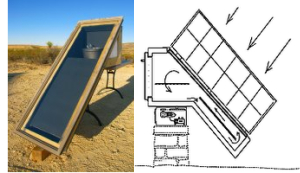 John
Wells has an interesting website where he blogs about being off the
grid completely somewhere in Texas.
John
Wells has an interesting website where he blogs about being off the
grid completely somewhere in Texas.
He has a good sense of humor and I have enjoyed hearing his take on how
off the grid living is working for him.
I would like to someday build a solar
oven like the one he finished last year in this picture. It would
be nice on really hot days not to add any more heat to the trailer and
save a bit of electricity at the same time.
Time for a quick state
of the farm report:
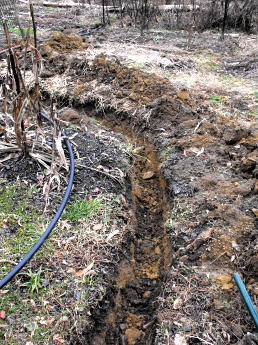
Cat status: Two feet apart from each other and fifteen feet away from
me. No hissing!
Chicken status: Pullets are laying well. Old girls are barely
laying and may soon be destined for the pot.
Garden status: A deer snuck past our predator eyes just before the new
year and ate up the last of our greens. So the only fresh things
we're eating out of our garden at the moment is Egyptian onions.
Luckily, our freezer is still two thirds full, so our weekly grocery
bill is pretty low. I'm already starting to think of spring
planting --- just a month until I can put in peas!
Water trench: I gave up on the trench because it hurt my carpal tunnel
too much, but Mark's been digging away at it. As you can see,
he's making major progress!
Weather: Gray. I dream of sunshine....
Creek: Coming back down.
Freelance work: Tricking in nicely.
Book I'm supposed to be writing: I'm actually writing it! Whipped
off the rest of chapter two last week.
I
dug up this open source children's story to spice up our journey
through winter. Stay tuned at lunch time every day (when I
remember) for installments of this early twentieth century Norwegian
tale. If you just can't stand the suspense, you can read the
whole thing at www.gutenberg.org.
LISBETH LONGFROCK
Translated from the Norwegian of
Hans Aanrud
BY LAURA E. POULSSON
Illustrated by Othar Holmboe
COPYRIGHT, 1907
style="font-family: Century Schoolbook L; font-weight: bold;">PREFACE
Hans Aanrud's short stories are considered by his own countrymen as belonging to the most original and artistically finished life pictures that have been produced by the younger literati of Norway. They are generally concerned with peasant character, and present in true balance the coarse and fine in peasant nature. The style of speech is occasionally over-concrete for sophisticated ears, but it is not unwholesome. Of weak or cloying sweetness—so abhorrent to Norwegian taste—there is never a trace.
Sidsel Sidsærk was dedicated to the author's daughter on her eighth birthday, and is doubtless largely reminiscent of Aanrud's own childhood. If I have been able to give a rendering at all worthy of the original, readers of Lisbeth Longfrock will find that the whole story breathes a spirit of unaffected poetry not inconsistent with the common life which it depicts. This fine blending of the poetic and commonplace is another characteristic of Aanrud's writings.
While translating the book I was living in the region where the scenes of the story are laid, and had the benefit of local knowledge concerning terms used, customs referred to, etc. No pains were spared in verifying particulars, especially through elderly people on the farms, who could best explain the old-fashioned terms and who had a clear remembrance of obsolescent details of sæter life. For this welcome help and for elucidations through other friends I wish here to offer my hearty thanks.
Being desirous of having the conditions of Norwegian farm life made as clear as possible to young English and American readers, I felt that several illustrations were necessary and that it would be well for these to be the work of a Norwegian. To understand how the sun can be already high in the heavens when it rises, and how, when it sets, the shadow of the western mountain can creep as quickly as it does from the bottom of the valley up the opposite slope, one must have some conception of the narrowness of Norwegian valleys, with steep mountain ridges on either side. I felt also that readers would be interested in pictures showing how the dooryard of a well-to-do Norwegian farm looks, how the open fireplace of the roomy kitchen differs from our fireplaces, how tall and slender a Norwegian stove is, built with alternating spaces and heat boxes, several stories high, and how Crookhorn and the billy goat appeared when about to begin their grand tussle up at Hoel Sæter.
Sidsel Sidsærk has given much pleasure to old and young. I hope that Lisbeth Longfrock may have the same good fortune.
LAURA E. POULSSON
Hopkinton, Massachusetts
Here's the view looking from above the wood stove just before sunset.
It was a good day for getting things done outside...a very good day.
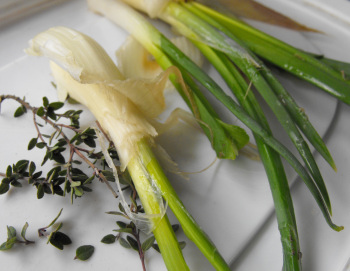 I know I wax eloquent about Egyptian onions
far too much, but if you haven't grown any before, you must give them a
shot! Right now, they're the only thing (beyond thyme) which is
actually green and growing in the garden.
I know I wax eloquent about Egyptian onions
far too much, but if you haven't grown any before, you must give them a
shot! Right now, they're the only thing (beyond thyme) which is
actually green and growing in the garden.
I have three beds of Egyptian onions, each one about three feet
by six feet and full of about a hundred plants. One bed is at the
furthest north edge of our garden where the winter sun is able to peek
up over the hill and warm the ground for nearly the full day --- this
bed feeds us green onion tops all winter long. The two beds on
the south end of the garden sit in ground which stays frozen for weeks
at a time due to shade from the hill --- these are onions I've been
saving for when I'm desperate for a hint of freshness.
Today I decided I was desperate. Out I went, trowel in hand,
expecting only to get a crisp white bulb. But once I peeled back
the speckled brown nubbins poking up out of the ground, I found the
most tender green shoots imaginable. Winter delicacy --- new
Egyptian onion shoots! Good thing I planted two extra beds so
that we can eat them whole and still have enough left to propagate come
spring.
(Read the beginning of the
story in the
archives. Note that several of
the images were scavenged off the internet. Click on the image to
find its source.)
CHAPTER
I: LISBETH LONGFROCK GOES TO
HOEL FARM
Bearhunter, the big, shaggy old dog at Hoel Farm, sat on the stone step in front of the house, looking soberly around the spacious dooryard.
It was a clear, cold winter's day toward the beginning of spring, and the sun shone brightly over the glittering snow. In spite of the bright sunshine, however, Bearhunter would have liked to be indoors much better than out, if his sense of responsibility had permitted; for his paws ached with the cold, and he had to keep holding them up one after another from the stone slab to keep from getting the "claw ache." Bearhunter did not wish to risk that, because "claw ache" is very painful, as every northern dog knows.
But to leave his post as watchman was not to be thought of just now, for the pigs and the goats were out to-day. At this moment they were busy with their separate affairs and behaving very well,—the pigs over on the sunny side of the dooryard scratching themselves against the corner of the cow house, and the goats gnawing bark from the big heap of pine branches that had been laid near the sheep barn for their special use. They looked as if they thought of nothing but their scratching and gnawing; but Bearhunter knew well, from previous experience, that no sooner would he go into the house than both pigs and goats would come rushing over to the doorway and do all the mischief they could. That big goat, Crookhorn,—the new one who had come to the farm last autumn and whom Bearhunter had not yet brought under discipline,—had already strayed in a roundabout way to the very corner of the farmhouse, and was looking at Bearhunter in a self-important manner, as if she did not fear him in the least. She was really an intolerable creature, that goat Crookhorn! But just let her dare—!
Read the rest of
today's chapter. To
be continued tomorrow....
With the golf cart not working the old yellow TC1840H
steel yard cart has been getting a serious work out these past few
weeks helping with firewood gathering.
It seems about twice as easy to pull if you catch the ground while it's
still frozen.
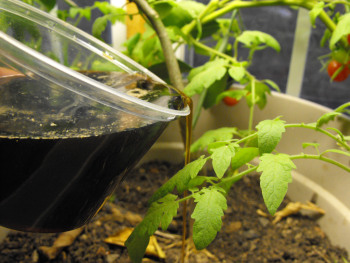 Our worms seem to be having a good time in
their worm box, though the cold makes them a bit sluggish.
Our worms seem to be having a good time in
their worm box, though the cold makes them a bit sluggish.
We put the box under the sink where there's a bit of drip, so water
slowly works its way through the composting leaves and organic matter
to collect in our bottom container. The drip keeps the worms
nicely damp and has also made us quite a bit of delicious compost
tea.
Since I started watering our lemon tree and tomato with the compost
tea, they've both been growing much faster.
Yay for compost tea!
(I'm posting this a bit early
because we're going to be in town all day. You can read the
beginning of the
story in the
archives if you
missed it.
Note that several of
the images were scavenged off the internet. Click on the image to
find its source.)
CHAPTER 2: LISBETH LONGFROCK AS
SPINNING WOMAN
 When Lisbeth found herself in the farm
dooryard, with the different
buildings all about her, she really had to stand still and gaze around.
Oh, how large everything was!—quite on another scale from things at
home. Why, the barn door was so broad and high that Peerout Castle
could easily go right through it, and each windowpane in the big house
was as large as their own whole window. And such a goat!—for just then
she caught sight of Crookhorn, who had come warily up to the doorway,
and who only saw fit to draw back as Bearhunter approached. Not that
Crookhorn was afraid of Bearhunter,—no, indeed!
When Lisbeth found herself in the farm
dooryard, with the different
buildings all about her, she really had to stand still and gaze around.
Oh, how large everything was!—quite on another scale from things at
home. Why, the barn door was so broad and high that Peerout Castle
could easily go right through it, and each windowpane in the big house
was as large as their own whole window. And such a goat!—for just then
she caught sight of Crookhorn, who had come warily up to the doorway,
and who only saw fit to draw back as Bearhunter approached. Not that
Crookhorn was afraid of Bearhunter,—no, indeed!
The goat was
larger than most goats,—about as large as a good-sized
calf. If the cows belonging to Hoel Farm were as much larger than
ordinary cows, thought Lisbeth, they would be able to eat grass from
the roof of Peerout Castle while standing, just as usual, on the
ground.
She glanced searchingly at the cow-house door. No, it was not larger
than such doors usually were, so the cows were evidently no bigger than
other cows.
Read the rest of today's chapter. To be continued tomorrow....
Dog or goat...which is more useful on
a farm?
Lee Johnson, Topeka, Kansas
That's a tough question. If you want a loyal friend that will almost
always be there watching your back and ready to lend a helping paw, then
a dog might be your best choice.
A goat can come in handy when you want to clear some land, or if you
need someone to drink a beer with, but they can be a real handful when
they get hungry and bored.
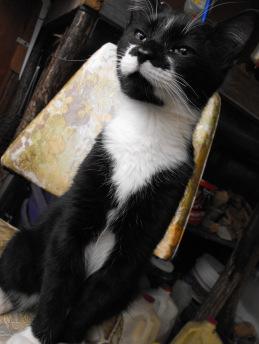 I have a hard time wrapping my head around
winter on the farm. I feel like it should be a time of
hibernation, of catching up on tasks that fell by the wayside during
the growing season, of contemplation.
I have a hard time wrapping my head around
winter on the farm. I feel like it should be a time of
hibernation, of catching up on tasks that fell by the wayside during
the growing season, of contemplation.
But I find myself instead turning winter into a long anticipation of
spring. Two weeks until I can prune the apple trees! Four
weeks until I can plant the peas! Two months until the first
spring flowers will peek out of the leaf mould!
I often think that Mark would make a good Zen monk --- he has an
enviable ability to live in the moment. I catch only glimpses of
such a mindset when I empty my head through a half hour of yoga, a long
walk, or a sketch in the outdoors. Strangely enough, I've also
been finding that intensity of focus while browsing the web in search
of images to include in the Lisbeth Longfrock posts. For hours at
a time, I feel like I'm transported to Norway, milking pesky goats into
wooden buckets. I'm sure there are much better uses of my time,
but as we all know, books are my mind-altering drug of choice.
(You can read the
beginning of the
story in the
archives if you
missed it.
Note that several of
the images were scavenged off the internet. Click on the image to
find its source.)
CHAPTER
3:
LEAVING PEEROUT CASTLE
 The next time Lisbeth Longfrock came to Hoel Farm, she did
not come alone; and she came—to stay!
The next time Lisbeth Longfrock came to Hoel Farm, she did
not come alone; and she came—to stay!
All that had happened between that first visit and her second coming had been far, far different from anything Lisbeth had ever imagined. It seemed as if there had been no time for her to think about the strange events while they were taking place. She did not realize what their result would be until after she had lived through them and gone out of the gate of Peerout Castle when everything was over. So much had been going on in those last sad, solemn days,—so much that was new to see and to hear,—that although she had felt a lump in her throat the whole time, she had not had a real cry until at the very end. But when she had passed through the gate that last day, and had stopped and looked back, the picture that she then saw had brought the whole clearly before her, with all its sorrow. Something was gone that would never come again. She would never again go to Peerout Castle except as a stranger. She had no home—no home anywhere. And at that she had begun to weep so bitterly that those who had been thinking how wisely and quietly she was taking her trouble could but stand and look at her in wonder.
Read the rest of today's chapter. To be continued tomorrow....
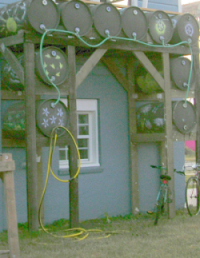 I like this creative daisy chain of 50
gallon barrels as a low budget solution for rain water collection in a
suburban setting. This is a picture I found on Flickr.
I like this creative daisy chain of 50
gallon barrels as a low budget solution for rain water collection in a
suburban setting. This is a picture I found on Flickr.
We've found these types of barrels used for around 8 bucks at some of
the local feed stores, which is most likely cheaper than buying a new
500 gallon container.
I guess the real question in a project like this is how much time and
additional materials will it take in comparison to the easy way?
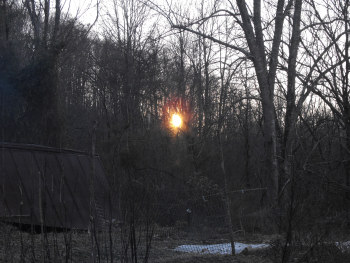 We came home from a day in the big city
Wednesday dragging our feet, worn out from shuttling between web
clients and my family. All I wanted was an easy, fast supper,
which generally equates to pesto pasta with veggies and a fried egg on
the side.
We came home from a day in the big city
Wednesday dragging our feet, worn out from shuttling between web
clients and my family. All I wanted was an easy, fast supper,
which generally equates to pesto pasta with veggies and a fried egg on
the side.
Imagine my dismay to open up the freezer and discover it
was...frozen. The gasket on our secondhand freezer has never been
the best, and water does slip in now and then, but somehow in the most
recent deluge gallons of water made its way into the body of the
freezer. A solid third of the produce was suspended in a block of
ice. All of the tomatoes, corn, and --- yup, you got it ---
pesto, was locked away out of reach. Read more....
(You can read the
beginning of the
story in the
archives if you
missed it.
Note that several of
the images were scavenged off the internet. Click on the image to
find its source.)
CHAPTER IV: SPRING: LETTING THE ANIMALS OUT TO PASTURE
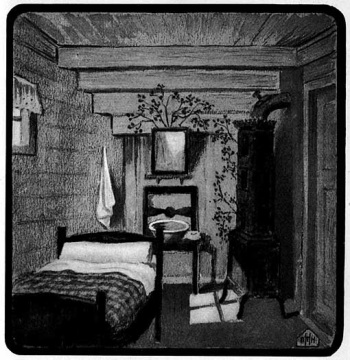 One morning, a few weeks after the sad departure from Peerout Castle,
Lisbeth Longfrock awoke early in the small sleeping room built under
the great staircase at Hoel. She opened her eyes wide at the moment of
waking, and tried to gather her thoughts together. She was conscious of
a delightful, quivering expectancy, and felt that she had awakened to
something great and new,—something that she had waited for and been
exceedingly glad over; but she could not at once remember just what it
was.
One morning, a few weeks after the sad departure from Peerout Castle,
Lisbeth Longfrock awoke early in the small sleeping room built under
the great staircase at Hoel. She opened her eyes wide at the moment of
waking, and tried to gather her thoughts together. She was conscious of
a delightful, quivering expectancy, and felt that she had awakened to
something great and new,—something that she had waited for and been
exceedingly glad over; but she could not at once remember just what it
was.
The little room, whose only furniture consisted of a bed, a chair, a stove, and a small wooden shelf with a mirror over it, was filled with daylight in spite of the early hour. The sun fell slanting down through a window set high up in the wall directly over Lisbeth's bed, and the windowpanes were pictured in bright yellow squares on the floor near the tiny stove. The corner of one square spread itself against the stove, and Lisbeth traced it with her eyes as she lay in bed. At the tip of the corner glimmered something light-green and shiny. Was it from there that a fine, wonderful fragrance came floating toward her? She sniffed a little. Yes, indeed! now she remembered. The fragrance came from the fresh birch twigs she had decorated the room with yesterday. Out of doors it was spring,—the sprouting, bursting springtime. To-day the cattle were to be let out and the calves named. To-day she would begin work in earnest and be a responsible individual. In short, she would be the herd girl at Hoel Farm.
Read the rest of
today's chapter. To
be continued next week....
 This small electric winch was made to pull a
4000 pound boat up onto its trailer. It can run on a 12 volt battery
and it has 20 feet of cable.
This small electric winch was made to pull a
4000 pound boat up onto its trailer. It can run on a 12 volt battery
and it has 20 feet of cable.
I'm thinking if it was mounted to a sturdy garden cart with a small
lawn mower battery it might have enough power to pull a loaded cart of
firewood up a steep hillside. Mystic
Marine has them on sale for just over 12 bucks with only an extra
10 for shipping.
Stay tuned to see if this idea makes it off the drawing board, or put
one together yourself and send me a picture of how awesome it is.
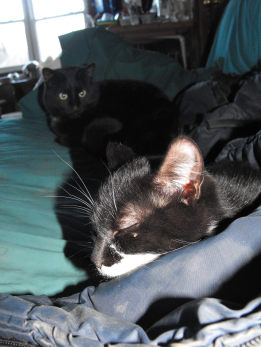 We've been making a bit of progress this week
on the cat front. In fact, Huckleberry has decided he wants to
play with Strider --- the whole point of a new kitten!
Unfortunately for all concerned, Strider seems to speak another
language and just ignores Huckleberry's advances.
We've been making a bit of progress this week
on the cat front. In fact, Huckleberry has decided he wants to
play with Strider --- the whole point of a new kitten!
Unfortunately for all concerned, Strider seems to speak another
language and just ignores Huckleberry's advances.
I'm hoping that the little cat will eventually start to feel a little
bit less traumatized --- he'll sit with me and purr, but at the first
sudden noise he leaps off my lap to run and hide under the futon.
He's terrified of Lucy and, when put outside, runs in a tail down slink
for the old house to hide.
On the other hand, those high end ear meds seem to have whacked out
most of Huckleberry's ear mites. I still see a tiny bit of
scratching, so I'm going to give him the second dose Monday. I
can't believe I let him scratch his ears until they bled for over a
year, trying one after another over-the-counter meds, and never thought
to take him to a vet!

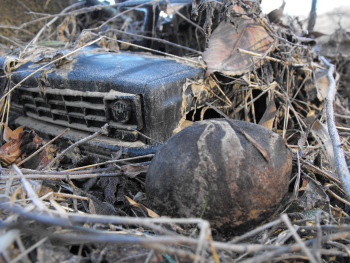
I proclaimed yesterday a "snow day" and decided we'd stay indoors
except for the bare necessities. It got even colder last night
(-1 F), but I couldn't resist checking out the world of ice this
morning.
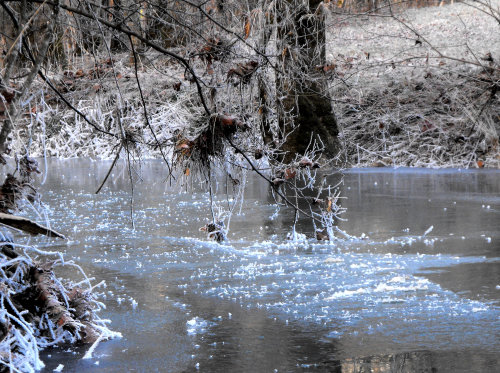
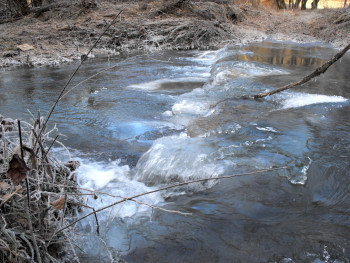
Sun doesn't hit much of our property until nearly noon at this time of year, so the photos lack sparkle. But you can probably get the idea --- ice everywhere!
The top layer of ice in the irrigation tank has been thick enough to
demand a heavy hammering in order to clear enough space to allow a 5
gallon bucket to be submerged.
This is what it must feel like to go ice fishing, although I hear one
needs to use a heavy saw to cut through much thicker ice than what we
have here.
 I'm going to take a break from our
lunchtime Lisbeth Longfrock series --- I've noticed that not many of
you got into the story, and the tale is starting to veer into
summertime. You can read
the ending over on the Project Gutenberg site.
I'm going to take a break from our
lunchtime Lisbeth Longfrock series --- I've noticed that not many of
you got into the story, and the tale is starting to veer into
summertime. You can read
the ending over on the Project Gutenberg site.
Meanwhile, Daddy has pulled together some fascinating information about
the connection between food and life. David Steinman, author of Diet
for a Poisoned Planet, has kindly given us permission to reprint
excerpts from his book here. Tomorrow through Friday, tune in for
a daily dose of food wisdom, peppered with specific information about
which conventionally grown vegetables are the safest to put in your
belly.
In other completely unrelated news, Joey is working on a spam filter
for the comments section of the website. He says that the only
downside is that there may be some false-positives. So, if you
try to leave a comment and it won't work, drop me an email!
Carrots
Carrots are relatively low in pesticide saturation. Sixty-three pesticide residues were detected in thirty six samples.... The pesticides DDE, iprodione and linuron were frequently detected. Organic carrots are widely available.... They are reasonably priced. --Diet for a Poisoned Planet, David Steinman, Thunder's Mouth Press, 2007 |
 The guys over at otherpower.com
have done an excellent job documenting their advanced projects in home
power generation with a series of easy to understand images.
The guys over at otherpower.com
have done an excellent job documenting their advanced projects in home
power generation with a series of easy to understand images.
The picture to the right is a steam powered engine they use as a back
up battery charger if their solar and wind systems fail.
It must be a good feeling to know you can make your own electricity
with fire. This set up cost them less than 500 hundred dollars thanks
to being in the right place at the right time.
I'm sure building something this big and heavy from scratch would require some
advanced skills and expensive tools and materials. I wonder if it's
possible to design a smaller version that would still be strong enough
to turn a small generator?
In the winter, I find
myself drawn to yoga. There's not much I can do in the garden
when the ground is frozen solid, and when it's 10 degrees outside I
just don't want to be out there. The perfect time to clear my
mind and stretch some muscles with yoga.
Although I love yoga when I do it, I've had less luck finding a way to
incorporate yoga into my weekly routine. A few years ago, I took
a class, which was useful for learning the basics but quickly turned
into a pain in the butt --- I hated driving half an hour to feel
uncomfortable about exercising around other people. Read more....
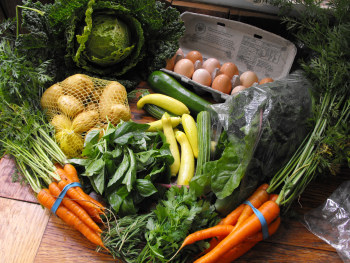 David Steinman grew up eating fish he and his
family caught in Santa Monica Bay, California. Much later, as a
journalist, he learned that all fish in that bay were polluted with
industrial chemicals, and portions of the bay became federal superfund
sites. In 1990, using information he gained from federal agencies,
Steinman wrote Diet
for a Poisoned Planet,
the result of years of research studying the food America buys in our
supermarkets. He updated the book in 2007.
David Steinman grew up eating fish he and his
family caught in Santa Monica Bay, California. Much later, as a
journalist, he learned that all fish in that bay were polluted with
industrial chemicals, and portions of the bay became federal superfund
sites. In 1990, using information he gained from federal agencies,
Steinman wrote Diet
for a Poisoned Planet,
the result of years of research studying the food America buys in our
supermarkets. He updated the book in 2007.
Steinman tells us how to
avoid consuming the poisons which fill many of our foods. Those which
are highest on dangerous chemicals contain animal fats. Read more....
This post is part of our Food and Health lunchtime series.
Read all of the entries:
|
The golf cart stopped working and I have not
been able to diagnose the exact problem. I found a guy in town that is
willing to work on it, but we have to get it there first.
We made some good progress today with me pulling and Anna pushing and
steering. Hopefully we can get it up the hill and loaded onto the
trailer tomorrow.
Yes...it is quite a workout pulling a full size golf cart through the
snow and mud and there's no way I could have made it as far as we did
without Anna pushing, which I guess is a pretty good metaphor for a
happy relationship where lots of exciting things get accomplished with
the combined effort of two people who work well together.
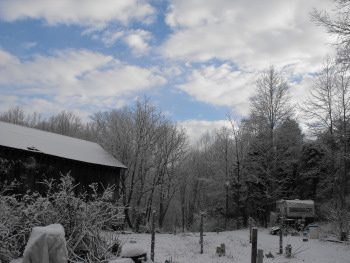 Operation golf cart went a lot more smoothly
than I'd thought it would yesterday. Until, that is, we reached
the ford.
Operation golf cart went a lot more smoothly
than I'd thought it would yesterday. Until, that is, we reached
the ford.
Mark gave a push and I hopped in to steer as the golf cart rolled down
the steep side of the ford. Then he rushed around across the
footbridge to pull it up the other side.
We only made it halfway up the other side of the ford before we gave
up. Mark was pulling with all his might and I was pushing with
all of mine, but the cart wouldn't budge. So we drove my little
blue Festiva down across snowy, ungravelled ground to try to pull it
out. Read
more....
 David Servan-Schreiber was a medical
researcher in his early thirties when he learned he had brain cancer.
After surgery, he searched for a way of life which would reduce his
chances of his cancer recurring. His book, Anticancer: A New Way of Life,
tells what he learned, scientifically, about how diet affects cancer.
David Servan-Schreiber was a medical
researcher in his early thirties when he learned he had brain cancer.
After surgery, he searched for a way of life which would reduce his
chances of his cancer recurring. His book, Anticancer: A New Way of Life,
tells what he learned, scientifically, about how diet affects cancer.
Dr. Servan-Schreiber's
experience with cancer changed him from a research career-driven
scientist to one interested in the practical application of science,
particularly the drawing together of divergent knowledge to find out
what prevents cancer and, once it has been treated, what prevents it
from recurring. He learned that healthy immune cells fight cancer in
its beginning, so it doesn't take over a body. Read more....
This post is part of our Food and Health lunchtime series.
Read all of the entries:
|
The ground was just too frozen today to get
any traction for pulling the golf cart and we decided it can wait till things thaws out a bit.
The TC1840
garden cart has been limping along with a flat tire and today was
the day we finally got around to replacing the inner tube.
We found the right size at a tire store in St Paul, and with a little
effort and some help from the portable
air tank we managed to get it back to full health which made
hauling tonight's load of firewood feel like a walk in the park.
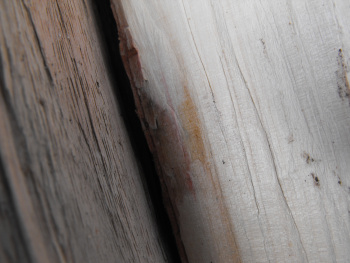 Cutting, gathering, and splitting wood are
nearly daily chores without the aid of the golf cart. Most of the
trees in our young forest are Black Walnut and Box-Elder, which
together seem to make a nearly perfect firewood.
Cutting, gathering, and splitting wood are
nearly daily chores without the aid of the golf cart. Most of the
trees in our young forest are Black Walnut and Box-Elder, which
together seem to make a nearly perfect firewood.
The Black Walnut weighs about twice as much as the Box-Elder, and the
weight difference equates to a slower burning wood which keeps us going
all through the night. The Box-Elder, on the other hand, is full
of air and ignites quickly, perfect for a nice hot morning fire to take
the chill off the house.
Unfortunately, the Box-Elder also rots much faster. We're still
working on cleaning up trees chopped down by the power company three
years ago, but the three year old Box-Elders are now too punky to split
and burn --- the maul sinks right into the decaying wood and we have a
devil of a time getting it back out. The three year old walnuts,
on the other hand, are still crisp and hard. I can't quite
describe the satisfaction of whipping your maul through a hard walnut,
hearing the deep thud echo against the hills as the two log halves fly
off in each direction.
Inflammation is key to
cancer formation. Cancer cells utilize our body's response to
inflammation to feed themselves. There are many anti-inflammatory drugs
available. However, each has bad side effects. Because drug companies
cannot make money off them, medical science has ignored the many
anti-inflammatory foods which are available. A diet rich in these foods
can help prevent cancers from developing or recurring.

Foods which aggravate
inflammation include: refined sugars, white flour, red meats from
industrially raised animals (see the documentary King Korn), oils rich
in omega-6 (such as corn, sunflower, safflower, soy), dairy products
from industrially raised livestock (especially if full fat), eggs from
industrially raised hens fed corn and soybeans, persistent anger or
despair, less than twenty minutes of physical activity a day, cigarette
smoke, atmospheric pollution, domestic pollutants. Read more....
This post is part of our Food and Health lunchtime series.
Read all of the entries:
|
The steering on the garden cart started going
a little hay wire on us during the afternoon hauling today. It turns
out the metal bar that connects the front wheel unit to the main body
decided to break in two pieces causing a jack knife effect when we
needed to take a turn.
We managed to create a quick fix with a standard shelf bracket bent
back just enough to line up with the screw holes which were the same
size as the holes in the bracket.
The new piece is three times thicker than the original part that came
from somewhere in China, and it held up perfectly on the next trip. I would even dare say it's an improvement over
the original design because it seems like it's more solid and rattles a
bit less.
--- Shannon
 Some homesteaders have gotten their lives
simplified to the point where they barely buy anything from the
store. We're in a sort of halfway house --- we do buy flour,
cocoa, sugar, dairy, tea, and some meat; keep two cars running; and pay
for high speed internet and electricity. On the other hand, we're
extremelly minimal in most respects and can live well on the poverty
line income for two people. If you're obsessed with clothes,
sports cars, or all of the latest electronic gadgets, you're obviously
going to have to make a lot more money. Read more....
Some homesteaders have gotten their lives
simplified to the point where they barely buy anything from the
store. We're in a sort of halfway house --- we do buy flour,
cocoa, sugar, dairy, tea, and some meat; keep two cars running; and pay
for high speed internet and electricity. On the other hand, we're
extremelly minimal in most respects and can live well on the poverty
line income for two people. If you're obsessed with clothes,
sports cars, or all of the latest electronic gadgets, you're obviously
going to have to make a lot more money. Read more....
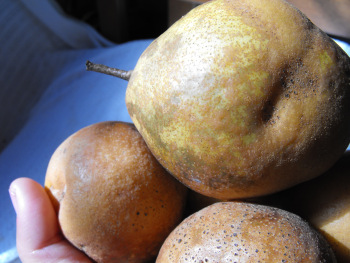 Diet
for a Poisoned Planet
has a different approach, identifying high-energy low-toxin foods which
not only fight cancer but also help prevent a host of other diseases,
from heart disease to Parkinsons to attention deficit disorder.
Diet
for a Poisoned Planet
has a different approach, identifying high-energy low-toxin foods which
not only fight cancer but also help prevent a host of other diseases,
from heart disease to Parkinsons to attention deficit disorder.
Eating plenty of plant
food is a key to eating healthy. Plants are low on the food
chain, and, the higher up that chain you eat, the more concentrated are
pollutants. "Cows, pigs, and other animals raised for slaughter
have concentrations in their flesh of chemical residues and biological
toxins from all the food they eat--thousands of plants laced with
chemical pesticides or fungal contaminants and microorganisms in their
feed. And the pesticides that accumulate in animal flesh are the
same ones that can accumulate in human flesh. The higher up the
food web you eat, the greater concentration of toxins you are likely to
consume. Humans, not surprisingly, are among the most poisoned
creatures on earth." Read more....
This post is part of our Food and Health lunchtime series.
Read all of the entries:
|
The ground thawed out enough today to get some
traction for pulling the golf cart up the hill. Once we got it up the
hill it took a while to figure out how to load it onto the trailer.
We decided to use the hand winch to pull it up another smaller hill to
take advantage of the slant. Then we used the winch again to secure one
side of the trailer to a tree and tied down the other side with a tow
strap. At that point it only took a carefully guided roll backwards to
seat it snuggly into place.
The trip into town will have to wait till tomorrow. It might seem like
a small problem to solve, but when I saw everything loaded up and tied
down I took a deep breath and felt like we had climbed a large mountain
and jumped a significant hurdle. The fact that we struggled through it
together made the victory even sweeter.
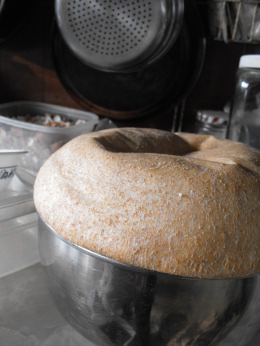 By lunchtime yesterday, I had a grant proposal
in the mail and a client's website updated. Time to go out and
play with Mark and the golf cart!
By lunchtime yesterday, I had a grant proposal
in the mail and a client's website updated. Time to go out and
play with Mark and the golf cart!
After the cut, I've included a bunch of photos about the process since
I figure it might be useful to other folks who need to get a large
piece of machinery up onto a trailer. The trick is to back your
trailer up to a steep enough hill so that the rear end of the trailer
ends up level with the ground.
Here you see the only party injured by the afternoon's activity.
I forgot about my bread dough and let it rise for four hours instead of
one. Oops. Luckily, the yeast still had plenty of gumption
left to rise again in the pan.
The photos....
 Did you know that studies showed, in
thirty-six market basket samples, potato chips had 207 residues of
toxic pesticides and industrial chemicals? But organic chips
didn't. Now I know why organic costs more--and why it's worth it!
Did you know that studies showed, in
thirty-six market basket samples, potato chips had 207 residues of
toxic pesticides and industrial chemicals? But organic chips
didn't. Now I know why organic costs more--and why it's worth it!
Unfortunately, many of us
can't afford organic foods or we live in areas where they are not
available. Diet for a Poisoned Planet looks at non-organic
commercial foods and lists them in three categories. Green light
foods are the safest. Eat plenty of them. Yellow light
foods have higher levels of pesticides, but should still be eaten if
organics are not available. Red light listed foods should be
replaced by organics. Still, the worst vegetable foods are better
for us than the worst animal foods. Read more....
This post is part of our Food and Health lunchtime series.
Read all of the entries:
|
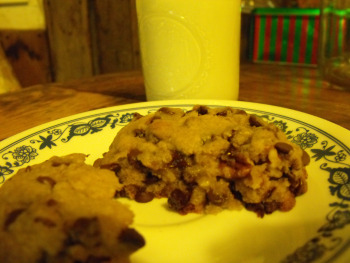 We got the golf cart to the mechanic this
morning. Yay!
We got the golf cart to the mechanic this
morning. Yay!
Now Mark's at a board retreat until Sunday afternoon.
So it's just me...and the cats...and the dog...and the chickens.
Keeping the fire going (I hope.)
And eating chocolate chip cookies with nuts (that Mark hates) baked so
that the center is nearly raw (which Mark hates.)
Sometimes it's good to have a weekend all my own. 
Time for the big test --- can
I keep a fire going overnight?
In pre-modern days (according to all the fiction I read, anyhow), if
you were in charge of the fire and let it go out, you were in big
trouble. Chances are you'd have to walk miles to your nearest
neighbor to borrow a coal from them. Luckily, we now have
matches, scrap paper, and fire starter logs, but I've never quite
developed the knack of getting a good fire going.
Mark usually wakes up once in the night to throw more logs on the fire
and I've started to consider our woodstove a lot like a linux-box ---
it never needs to be rebooted. I didn't plan to, but I ended up
following suit, loading up a mass of box-elder as the first hint of
light entered the sky. When I opened the stove up again a few
hours later --- success!
(To be honest, though, I have to admit that it never got below freezing
last night and my fire gave off nearly too much heat!)
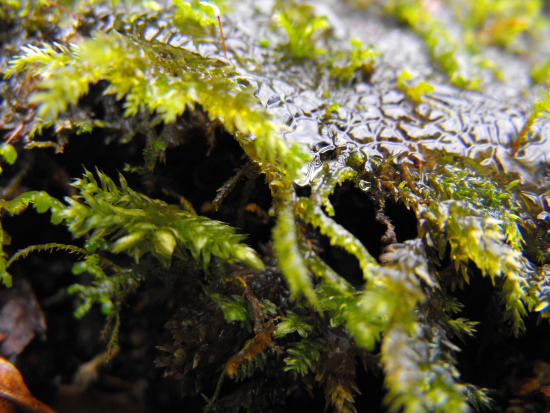
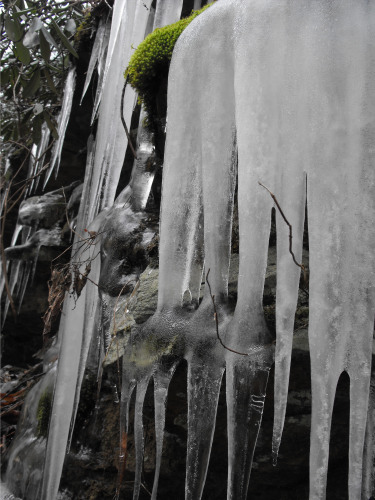 I should be taking advantage of this warm
spell to chip away at the freezer, but instead I took Lucy and the
camera up into the national forest to explore. There is a
trailhead for a National Scenic Trail about 15 minutes from my house
and I'd never taken the time to check it out --- shame on me!
I should be taking advantage of this warm
spell to chip away at the freezer, but instead I took Lucy and the
camera up into the national forest to explore. There is a
trailhead for a National Scenic Trail about 15 minutes from my house
and I'd never taken the time to check it out --- shame on me!
The sun was hidden, but I still managed to capture some interesting ice
photos. When I reached the magnificent waterfall at the end of
the trail, though, I put the camera away and simply sat on a ledge over
the falls, letting the crashing water block out the rest of the
world. On the walk back to the car, a raven circled us
repeatedly, croaking out some message I was too dull to decipher but
which left me soaring on winter woods endorphins.
Six miles later, I'm back home. The trailer is warm, the sun is
beginning to come out, and two cats are cuddled up beside me. A
perfect Saturday.
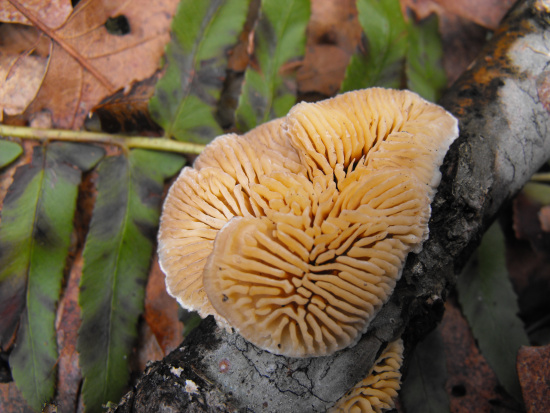
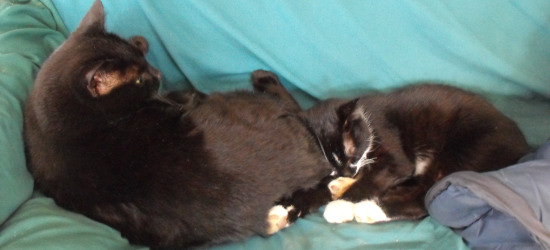
There was some licking going on too. And even a bit of tentative play. Now, if Huckleberry will just learn that playing doesn't involve biting through Strider's jugular. And if Strider learns not to eat my breakfast out of my hand....
My great aunt Ruth
Tirrell wrote for Organic Gardening and for the New York Times during
the '60s and '70s, and I've inherited my Egyptian onions (and perhaps
my green thumb) from her. I got permission from Organic
Gardening Magazine to reprint some of my Aunt Ruth's articles here in
my blog.
Stay tuned Monday through Friday for the next two weeks for sections
from her article "Planting for a 4-Season Harvest." For those of
you who enjoyed Daddy's posts this past week, don't despair --- he'll
return in a few weeks with another series. Enjoy!
Planting
for a 4-Season Harvest
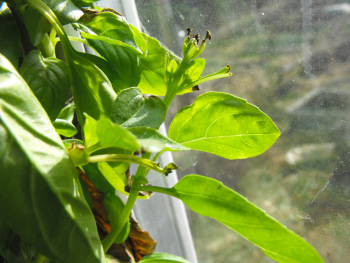 Planting time in suburban
Boston begins in the house in late
February. That's when I sow eggplant, lettuce, and the first
tomatoes in a small flat, to be set out early under protection. A
few weeks later, I start cabbage, broccoli, or cauliflower along with
peppers and the main tomato crop, Big Boy. Once in a while I sow
leeks inside, but there's no real need. Read more....
Planting time in suburban
Boston begins in the house in late
February. That's when I sow eggplant, lettuce, and the first
tomatoes in a small flat, to be set out early under protection. A
few weeks later, I start cabbage, broccoli, or cauliflower along with
peppers and the main tomato crop, Big Boy. Once in a while I sow
leeks inside, but there's no real need. Read more....
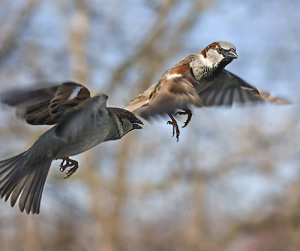 Cory
over at Boing Boing has a nice book review which pointed me to Rick
Lieder's amazing nature photographs.
Cory
over at Boing Boing has a nice book review which pointed me to Rick
Lieder's amazing nature photographs.
I've been really enjoying his collection online and feel a bit inspired
by the fact that he doesn't use high speed film or any fancy tricks to
capture moments like in the picture here.
I spent a busy weekend as a new board member of Appalachian Community
Fund sifting through applications and deciding as a group which
ones best fit the vision of social change by encouraging grassroots
networking in the Appalachia area. I'll speak more about this in the
future as I become more experienced with the organization and the grant
making process.
In the meantime, if you're looking for a good cause that's serious about
working to overcome the underlying causes of poverty and injustice in
Central Appalachia then I suggest you consider ACF for your next
charitable donation. I can personally vouch for this group and assure
you that it's on the complete up and up. It's a no frills way of
getting much needed money to groups in this area that have always
struggled with unusually high levels of poverty.
A Window
"Greenhouse"
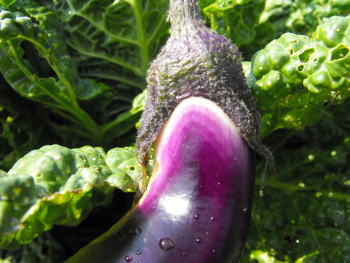 A sunny window is my
"greenhouse." Eggplant, pepper, and tomato
go in a heated room; the others, more hardy, in a cool bedroom.
The tender seedlings are removed from the sill at night, but the room
itself is cooler than in daytime. Except on very cold nights, I
merely draw the shade between the glass and the comparatively hardy
crops. These methods give good results (I admit a greenhouse
would give better); if there are failures, it is my fault. Once
I forgot to take flats of eggplant and tomato out of the window at
night. Read
more....
A sunny window is my
"greenhouse." Eggplant, pepper, and tomato
go in a heated room; the others, more hardy, in a cool bedroom.
The tender seedlings are removed from the sill at night, but the room
itself is cooler than in daytime. Except on very cold nights, I
merely draw the shade between the glass and the comparatively hardy
crops. These methods give good results (I admit a greenhouse
would give better); if there are failures, it is my fault. Once
I forgot to take flats of eggplant and tomato out of the window at
night. Read
more....
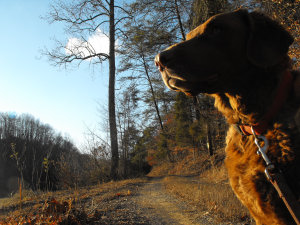 The golf cart is now safe and sound back on
the farm.
The golf cart is now safe and sound back on
the farm.
I didn't get the technical details of what exactly was wrong due to the
mechanic not being in the shop, but hopefully we'll find out from him
later what the major malfunction was.
I'll put the traction straps back on the wheels tomorrow and that
should put us back in business for navigating the muddy driveway.
I'm thinking of printing
notecards using some of my recent photographs. It's hard
to choose photos that will look good small since I've seen them all
large, though, so I'm hoping to get some advice from those of you who
can see the images with fresh eyes. Thanks in advance for your
input!
1.
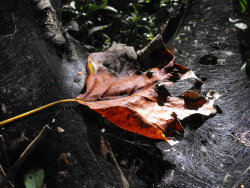
2.
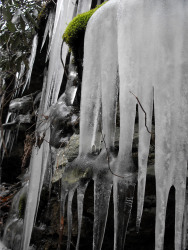
3.
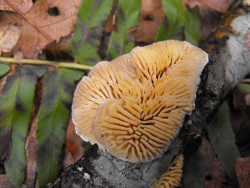
4.
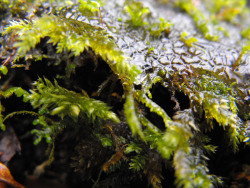
5.

(Wrapped around both the front and back of the notecard.)
6.
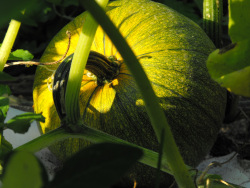
7.
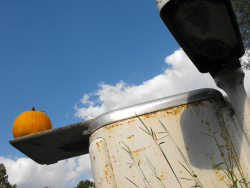
8.
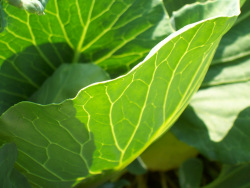
9.
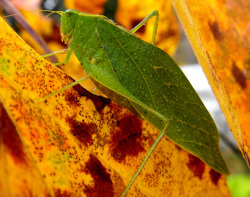
10.

(Wrapped around both the front and back of the notecard.)
Peas First
Row Crop

Long before tomato seedlings get into the garden, I sow my first row crop --- peas. If ground has thawed by mid-March, peas go in. A few days before, winter mulch is raked aside temporarily to let soil warm up. From then on, I make sowings of peas every week until May first. The aim is: peas every day during June and the first week or so of July. The early sowings --- but not the earliest, for peas may rot in the cold, wet ground --- make the best crops. Read more....
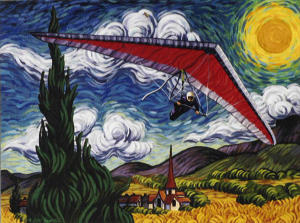 I found out recently that you can listen
to the Writer's
Almanac for free at their website and catch up on past shows that
you've missed.
I found out recently that you can listen
to the Writer's
Almanac for free at their website and catch up on past shows that
you've missed.
It's a five minute gem of a radio show that always seems to educate,
entertain, and inspire me with its style and content.
I love the way he weaves in yummy slices of historical trivia, for
example, "On this day in 1978, the Commerce Department, which oversees
the National Weather Service, announced that hurricanes would no longer
be named exclusively for women."
The smooth voice of Garrison Keillor
is the host of the show and he
always signs off with the warm greeting "Be well, do good work, and
stay in touch." It's like hearing from your favorite English teacher on
what's got him or her excited that day without the annoying kid in the
back throwing spit balls.
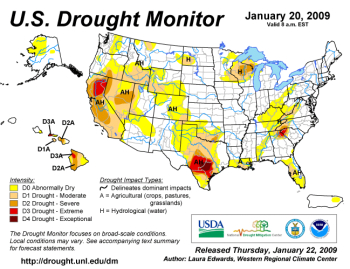 Another inch and a quarter of rain fell
Tuesday, sending me scurrying to the USGS website to check in
on our drought conditions. Here in southwest Virginia, we're
still in a moderate drought --- I dream of downgrading to abnormally
dry.
Another inch and a quarter of rain fell
Tuesday, sending me scurrying to the USGS website to check in
on our drought conditions. Here in southwest Virginia, we're
still in a moderate drought --- I dream of downgrading to abnormally
dry.
We just need 6 to 9 inches of rain in the next month to end this
drought. If drought amelioration were a fundraising campaign, I
could totally work with those numbers, but I'm afraid that my pep talks
will hold little sway over the weather.
Mulch
Replaced After Soil Heats Up
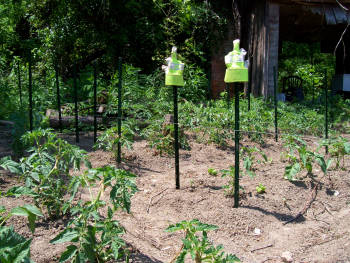 As with the peas, the leaf
mulch is raked aside before planting and
afterwards, when the ground heats up, is raked back again. This
mulch is also necessary over the winter to keep my clay soil from
compacting and getting water-logged; it makes early planting
possible. Using mulch year after year also loosens and lightens
the soil.
As with the peas, the leaf
mulch is raked aside before planting and
afterwards, when the ground heats up, is raked back again. This
mulch is also necessary over the winter to keep my clay soil from
compacting and getting water-logged; it makes early planting
possible. Using mulch year after year also loosens and lightens
the soil.
No special preparation for
planting may be needed; often I just make a
furrow and plant. But for long-rooted crops in clay soil, better
results will be obtained when a two-foot strip along the row is loosed
with a spading fork. This applies particularly to beets, carrots,
parsnips --- all your crops, if there's time. It's not too much
work, and the whole garden can be done in a few years by alternating
rows --- in any one year I never spade up the entire garden. Read more....
I took this picture today in the middle of my evening walk with Lucy.
I've heard from four separate people around here that this bridge is
haunted by an older lady wearing a long night gown, although I have yet
to speak to anybody who's actually seen anything ghost like.
Maybe someday I'll get lucky and snap a picture of said ghost in the
future, if there is actually any such thing?
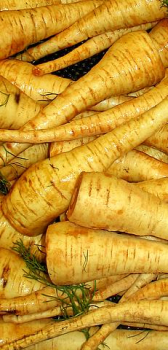 You may not believe it now, but until I
started gardening I was a massively picky eater. I didn't like
leafy greens, garlic, onions (just cut them on the same cutting board
with something I liked and I wouldn't eat any of it!), winter squash,
summer squash --- the list goes on and on.
You may not believe it now, but until I
started gardening I was a massively picky eater. I didn't like
leafy greens, garlic, onions (just cut them on the same cutting board
with something I liked and I wouldn't eat any of it!), winter squash,
summer squash --- the list goes on and on.
Now I find myself excited to try new vegetables and unable to name any
I don't like. (Maybe canned olives?) The few I no longer
grow are simply because they require too much babying and aren't my
very favorites.
So I was thrilled when Mom gave me a parsnip to taste test. I
cooked it up with some free range turkey and dumplings today (and
onions, garlic, sweet potatoes, and thyme.) The verdict ---
delicious! Sweet as a carrot!
Information on growing parsnips is a bit scanty. From what I
understand, it needs to be in the ground quite a bit longer than a
carrot, so should be planted about 100 days before your first fall
frost. I plan to hunt down some seeds then plant my first
parsnips June 30.
Exempts
Eggplant and Peppers from Early Transplanting
 Eggplant and peppers are
not subjected to early transplanting because
they're more tender, especially eggplant. It may seem harsh
treatment in cold, raw weather for the tomatoes, and I do delay
planting in some years. Remember: Tomatoes
must be well-protected when set
out before their regular time.
Eggplant and peppers are
not subjected to early transplanting because
they're more tender, especially eggplant. It may seem harsh
treatment in cold, raw weather for the tomatoes, and I do delay
planting in some years. Remember: Tomatoes
must be well-protected when set
out before their regular time.
...When all danger of even
light frost is over, the tender crops go
in. In my area, that means about May 30; in northern New England,
even later. In areas of short summers, most gardeners risk a few
plantings ahead of the "safe" date. I sow a few bush beans in
early May, and perhaps a hill or two of summer squash, protected under
a hotcap, glass jug, or loose mulch of leaves or straw. Last May
I planted Spring Gold, an early corn that starts well in cool weather.
To be continued....
Tirrell, R. 1966, February. Planting for a 4-Season
Harvest. Organic Gardening and
Farming.
Reprinted by permission of Organic Gardening magazine. Copyright
Rodale, Inc., U.S.A. All rights reserved. www.organicgardening.com.
This larger than normal Stihl chainsaw
has been one of the most reliable gas powered tools I've ever had the
pleasure of operating. It gets a bit heavy sometimes to carry, but the
extra power really comes in handy.
Last week it started to sputter and stall and seemed to be functioning
at barely half power.
My first guess was right, it had some bad gas. I poured out the old
stuff and put a fresh new gas oil mixture in and it zipped back to 100
percent. I made the mistake of buying two 5 gallon containers of gas
back in the summer when it seemed like the price was going through the
roof. Now I know how long is too long for storing fuel for our machines.
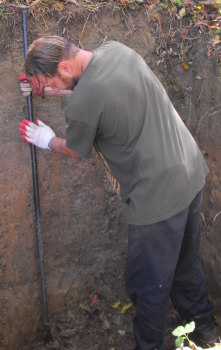 When we got the golf cart back Monday, we
started to drive it back to the house and promptly bottomed out.
We were tired, cold, and wet, so decided to leave it for the time being.
When we got the golf cart back Monday, we
started to drive it back to the house and promptly bottomed out.
We were tired, cold, and wet, so decided to leave it for the time being.
Then it poured down rain for two days, and we got sidetracked with
other important chores (including taking Strider to be snipped!)
Finally, yesterday afternoon, I headed out to poke at the golf cart
again. I brought Mark's favorite hand tool --- the spud bar (more
commonly known as a tamping bar.) I can barely lift the thing,
but it's extremely useful for breaking up soil when digging, then
compacting the soil when putting it back in place around a
fencepost. I figured it might also work well as a lever to pry
the golf cart up off the ground.
I slipped the spud bar under the grounded portion of the cart and
lifted. Whee! --- the cart slid down the tilted spud bar and up
the hill. The rainy weather and endless grant proposal I've been
working on had me a bit down in the dumps, but the satisfaction of
pulling the cart loose jolted me back into a good mood. The spud
bar --- mother's little helper.
Starts
Tomatoes Outdoors
 Tomato seed can be sown now
directly in the ground, novelty varieties
such as Cherry or Yellow Pear, which don't take so long to
mature. Or more "early" tomatoes which grow more quickly than the
main crop and will be ready to take over when the first lot of tomatoes
is petering out in late summer.
Tomato seed can be sown now
directly in the ground, novelty varieties
such as Cherry or Yellow Pear, which don't take so long to
mature. Or more "early" tomatoes which grow more quickly than the
main crop and will be ready to take over when the first lot of tomatoes
is petering out in late summer.
For most tender crops,
though,
wait until the environment is thoroughly
warm for the second big planting period of the gardener's year.
The following go in: lots of bush beans, cucumber, summer squash.
I plant 3 kinds of this favorite vegetable: White Bush Scallop; some
form of the dark-green Italian zucchinni; a Yellow Summer. Last
year I grew two: Early Prolific Straightneck and Seneca Butterbar
Hybrid; the first pale yellow, the second, buttery, and both
good. Read
more....
Here's another view of our homemade footbridge
taken this evening.
I'm going through a phase lately where I want to replace it with a set
of ziplines,
although I'm not sure if Lucy would be up for such a ride?

It was a slow Saturday on the farm today. We
try to make time for rest and relaxation on the weekends if at all
possible. The photo above was taken just before sunset today out by a
curve in the driveway with the Fuji
S1000 fd, which is only getting more valuable to me as I delve
deeper into it's many cool features. If you're in the market for a
digital camera in the 150-200 dollar range you might want to give it
a look.
Want more in-depth information? Browse through our books.
Or explore more posts by date or by subject.
About us: Anna Hess and Mark Hamilton spent over a decade living self-sufficiently in the mountains of Virginia before moving north to start over from scratch in the foothills of Ohio. They've experimented with permaculture, no-till gardening, trailersteading, home-based microbusinesses and much more, writing about their adventures in both blogs and books.
